Camouflage and Markings of the North American P-51 Mustang
Another reprint from my editorial archives is this camouflage feature by Mr Rick Kent, originally posted at the pages of IPMS Stockholm – Ed.
The Mustang did not gain it's immortal fame until this American airframe was married with the British Merlin engine. Providing long-range escort to B-17s and B-24s, the Mustang carried the air war to the heart of Germany. By war's end, P-51s had destroyed 4,950 enemy aircraft in the air, more than any other fighter in the European theatre.
An amazing array of firsts was piled up by the Mustang. It was the first single-engined fighter based in Britain to penetrate Germany, first to reach Berlin, first to go with the heavy bombers over the Ploesti oil fields and first to make a major-scale, all-fighter sweep specifically to hunt down the German Luftwaffe.
One of the highest honors accorded to the Mustang was its rating in 1944 by the Truman Senate War Investigating Committee as "the most aerodynamically perfect pursuit plane in existence."
The P-51D is also the most numerous warbird fighter aircraft still flying, with more than 100 airworthy examples around the world.
This profile collection is devoted to the P-51s in the U.S. wartime service. I will present the selected USAAF Mustangs in order of the Air Force numbers they served with. Let's begin with the 5th Air Force.
5th Air Force
The 35th Fighter Group was re-equipped with P-51D's in March 1945, having previously flown P-47's. They were in natural metal finish with the black theatre bands on fuselage and wings and also the pre-war style rudder striping used on a number of 5th AF Fighter Groups. The rest of the markings all refer to the 39th Fighter Squadron, namely the blue nose and stripes above and below the fin number and also the number 34 itself (the 39th used the range from 10 to 39, with any additional aircraft having 100 added to them, so the 31st aircraft would be 110 and so on). The other two squadrons in the Group were the 40th (red colours and numbers 40 to 69); and the 41st (yellow with 70 to 99).
As a note for modellers of any World War II USAAF operational aeroplanes and their colour schemes I would highly recommend the series of books on the different Air Forces written by Kenn C. Rust, and published by Historical Aviation Album at various dates in the 1970's. Most of the information above, for example, was researched from his "Fifth Air Force Story".
8th Air Force
Here is the first of three 8th AF Mustangs, in this case a B model of the 352nd Fighter Group. Colouring is the standard Olive Drab upper with Neutral Gray under camouflage. The aircraft carries full set of D-Day stripes (above wing as well) necessitating repositioning of the aircraft letter on the nose, and the blue nose markings of the 352nd.
Here's the second 8th AF Mustang - a P-51D of early type without fin fillet of the 363rd FS 357th FG. The pilot of HORSES ITCH was Major Edwin W. Hiro who was killed in action in this aircraft on either September 18th or 19th 1944.
The time is not long after D-Day so the stripes are still on the under surfaces. The 357th had not yet applied its coloured markings at this stage, so the standard earlier white nose and bands on the tailplane were still in use. These aircraft were camouflaged around the time of D-Day, having been natural metal.
There are a number of accounts which state that 8th and 9th AF aircraft so painted were done with paints obtained from the RAF locally rather than with the US shades of Olive Drab and Neutral Gray; hence I have shown this aircraft in RAF Dark Green uppers and Medium Sea Grey lower surfaces. In photos the undersides on the 363rd look too light to be Neutral Grey which was a much darker shade somewhat similar to RAF Dark Sea Grey. However, in the last analysis, the modellers must make up their own mind about the precise colours used. Note that this aircraft has three small victory markings just forward of the windshield. Also note that there are different styles of lettering: the 'B' and 'D' are squared off, whilst the '6' is rounded.
This P-51D, serial no. 413926 was normally flown by Lt. Abe P Rosenberger; however it was lost (KITA) while being flown by Lt. Donald D Dellinger on 9 August 1944, only three days after the Invasion. I can only guess that KITA means Killed in Take-off Accident.
The paint scheme might be a little controversial with regard to the upper surface camouflage colour. As you can see I have done my profile with Dark Green (RAF paint), though like the last one it might be US Olive Drab. I have a colour photo of it in a couple of publications and it certainly looks too green to be Olive Drab. The camouflage covers the whole of the tops of the wings and tailplane, the rest of the aircraft being in natural metal.
The controversy is that some publications have stated that these P-51's of the 361st Fighter Group were painted blue on the upper surfaces, but having seen the photos I am convinced that the others are right in stating Dark Green or possibly Olive Drab. It may be that some of their aircraft were painted with Insignia Blue but not all of them - Roger Freeman states in The Mighty Eighth that the US fighter units in the UK were really left to their own devices as to how to camouflage the tops of their aircraft after D-Day and that some did use Insignia Blue, but most obtained Dark Green from British sources).
The D-Day stripes on the undersides are obvious as is the yellow nose Group marking (the squadron coloured rudders were not introduced until later in 1944, by which time camouflage had practically disappeared from 8th AF fighters with the exception of the P-47's of the 56th Fighter Group).
9th Air Force
Here is a 9th AF Mustang. What makes this one interesting for modellers is that the markings are the ones that Airfix provided for their very first Mustang kit when it came out about 40 or so years ago. I remember eagerly buying it then well, dare I say! The kit instructions did not make any mention of the blue nose or D-Day stripes unfortunately, nor did they say that it was a 9th AF machine, which was very confusing at that time as the only USAAF codes that had been published at all were those of the 8th and so did not include 'A9'.
There is not a tremendous amount to say about the colouring of this early type P-51D as it's mostly obvious. The D-Day stripes have been overpainted on the top surfaces with either Dark Green (British) or Olive Drab (US) paint. The anti-glare panel ahead of the cockpit is the original Olive Drab. The blue nose is the 380th Fighter Squadron colour - the 9th had the squadron colours on the nose rather than the group as in the 8th.
There are also standard P-51 black recognition bands around the tailplane - but not the fin. Otherwise the airframe is natural metal overall. A photo of this aircraft appears on page 100 of Kenn C. Rust's book The 9th Air Force in World War II, published in 1970 by Aero Publishers, California, ISBN-0-8168-7025-X.
10th Air Force
Now we come to the 10th Air Force based in India and Burma, and the famous 1st Air Commando Group as shown here on one of it's earlier Allison-engined P-51A's. Overall colour scheme is the standard US Army Olive Drab and Neutral Gray. This is decorated with the white diagonal stripes and other white markings on the nose, fin and rudder, plus the wing and tailplane (but not elevator!) tips.
Nicely added to by the name Carol's Daddy on the nose in a type of Old English script. As you can see the individual aircraft number '18' is painted in white over the orange yellow serial number (36113). The direction-finding loop on top of the rear fuselage was a normal fitting on Mustangs in the China/Burma/India theatre.
Here's the second 10th AF, 1st ACG Mustang, but this time a natural metal P-51D. The markings of black band to the rear of the spinner, diagonal fuselage stripes, and chequered fin and wingtips - but not tailplane on this particular aircraft - are all fairly obvious, as is the individual identification number '66' under the cockpit. Note that the D/F loop and radio aerial mast are also black. The name Sigh! on the nose is interesting in being two colours with red letters and black '!'. The anti-glare panel is Olive Drab.
The third and last 10th AF Mustang represents the 2nd ACG. As with the previous 1st ACG machine we have a basically natural metal aircraft with black markings apart from the Olive Drab anti-glare panel.
The standard recognition bands appear on the vertical tail and around the wings - but on this one not on the tailplane. Also the spinner is black. The unit markings consist of the '!' which interrupts the fin band and the lightning flashes. The latter are also on both top and bottom of the wings, each side of the recognition band, the lightning flashes being angled with the points meeting each side of the band at the leading edge. The national insignia, of course, is over the top of the outer lightning under the right wing and on top of the left.
The rear cockpit canopy frame is also black as is the individual aircraft number '84' on the nose. Note that this aircraft does not have the D/F loop on the rear fuselage.
14th Air Force
Here's a Mustang of the somewhat forgotten 14th AF which operated in China from 1943 onwards to the end of the war, having been split away from the 10th in India/Burma.
As you can see, it is a P-51C model with the normal natural metal finish and Olive Drab anti-glare panel. The serial number is moved from the fin to the rear fuselage to make way for the Group/Squadron markings and the large number '1061' is the individual aircraft identification. The whole 311th Fighter Group had yellow tails with two black bands; the 530th Fighter Squadron having its diagonal bands sloping from top right to bottom left, while the other two Sqns had theirs either vertical or sloping the opposite way. The red nose was also a squadron marking.
Many planes of this Group had a girl's name on the nose but very few had any artwork.
15th Air Force
There were four Fighter Groups of the 15th AF based in Italy which were equipped with the P-51. This P-51C shows the earlier style of 52nd Fighter Group markings over the usual natural metal finish with Olive Drab anti-glare panel.
The main Group marking was the yellow band edged in black around the fuselage; this was repeated around the outer wing tip and midway round the tailplane in various combinations. Some fighters had both, some had only one - this particular aircraft only has the wing tip band but no tailplane bands.
The yellow band around the inboard wing on this aeroplane was a common P-51 identification marking in Italy and not a Group marking. Likewise, the red nose was common to all allied fighters in the Mediterranean theatre.
The 2nd Fighter Squadron is identified by the code letters 'QP' on the fuselage, the individual letter 'L' in black being on the vertical tail. These individual letters were always on the fin for all three squadrons of the Group, sometimes plain black or sometimes yellow outlined with black. The 4th Fighter Squadron was coded 'WD' and the 5th FS 'VF'; thus the codes for the three Sqns of the 52nd Group duplicated those of the famous 4th Fighter Group (the Debden Eagles) of the 8th AF based in the UK.
Later on, towards the end of WWII, the 52nd changed its markings to an all yellow tail and rear fuselage, retaining the wing tip bands.
The second of my 15th AF Mustangs is this early type P-51D of the 31st Fighter Group with their red diagonal stripes on the vertical tail. Note also the yellow bands around the wingtips (later on the tips themselves were painted red).
The nose is again standard red theatre marking for all Allied fighters and the overall finish is natural metal with Olive Drab anti-glare panel. The 308th Fighter Squadron is identified by the 'HL' code letters, the other two Sqns of the Group, the 307th and 309th, being respectively 'MX' and 'WZ'; these code letters duplicated those of the 78th Fighter Group of the 8th AF based in the UK.
Another 15th AF Mustang, this is a late type P-51D of the 332nd Fighter Group.
Unfortunately by modern standards, during World War II the US Army practiced a policy of strict segregation of black people, so this Group was entirely manned by black Americans. Their proud claim at the end of the war was that they never lost a single bomber under their escort, which is a tremendous record.
The Group was identified by their all red tails and in some cases wingtips like this one. The Group had four Squadrons (99th, 100th, 301st and 302nd) of which the 302nd was identified by the number range 70 - 90 and the colour yellow on tail trim tabs and the band behind the spinner. The red spinner is of course the standard Allied fighter marking; and the yellow bands around the inner wings were standard P-51 ident markings. The basic finish is the usual natural metal with Olive Drab anti-glare panel.
The last of the 15th AF Mustangs is this P-51D of the famous "Checkertail Clan" 325th Fighter Group. Apart from the chequered fin/rudder, rear fuselage and tailplane the Group had the black outlined yellow bands near the wingtips (near to the end of the war some aircraft had checks on the wingtips).
This aircraft also has the inboard yellow bands around the wings, and, of course, the usual red nose. The three Squadrons of the Group (317th FS, 318th FS and 319th FS) did not use any separate colour ident, but each had its own range of ident numbers, in this case 70 - 99 for the 319th. Overall colour scheme is the usual natural metal with Olive Drab anti-glare panel.
20th Air Force
Now we move on to the 20th AF. There were three P-51D Groups in the 20th AF, the 15th, 21st and 506th, identified respectively by the number ranges 50-199, 200-349, and 500-649.
The 15th Fighter Group was composed of the 45th, 47th, and 78th Fighter Squadrons which were respectively numbered 51-99, 150-199, and 100-149, hence this 45th Fighter Squadron aircraft is number '56'.
The green markings edged in black are also Squadron marks; there were no distinctive coloured Group markings as such. Some aircraft of the 45th Fighter Squadron had the diagonal bands repeated on the wings and tailplane.
The overall finish is the standard natural metal with Olive Drab anti-glare panel. This particular aircraft has the normal single radio mast on top of the fuselage, but modellers should note that many 20th AF P-51D's had two masts side by side.
This P-51D shows the markings of the 47th Fighter Squadron of the 15th Fighter Group: all of the black/yellow markings are Squadron markings, as well as the fuselage identification number '150'. Note that this aircraft has two radio masts side-by-side, which are painted black also.
The only other thing to say is that the finish is as per usual in natural metal with Olive Drab anti-glare panel.
The third of the 20th AF Mustangs is this one of the 21st Fighter Group. The three Squadrons of this Group (46th, 72nd, and 531st) all had the same markings but in different colours - light blue, yellow, and white respectively - and different individual aircraft ident number ranges: 200-249 for the 46th, 250-299 for the 72nd, and 300-349 for the 531st. All the squadron coloured markings were edged in black as shown on this one.
This one also has its two radio masts painted blue. The name on the nose Little "ANGEL" the 104 is in black and red. Yet again this is a natural metal aircraft with Olive Drab anti-glare panel.
Here's the last of the USAAF Mustangs in this roundup, this one of the 506th Fighter Group, 20th AF.
The three Sqns (457th, 458th, and 462nd) of the Group had similar markings in different colours and also had different series of ident numbers (457th 500-549, 458th 550-599, and 462nd 600-649). The squadron markings consisted of painting the fin, rear fuselage and tailplane all over in a colour. As shown here, the 457th was red; the 458th had black diagonal stripes over the natural metal background, and the 462nd was yellow.
Otherwise the finish was standard in natural metal, including propeller spinner, with Olive Drab anti-glare panel. Note that this particular aircraft has two aerial masts side-by-side.
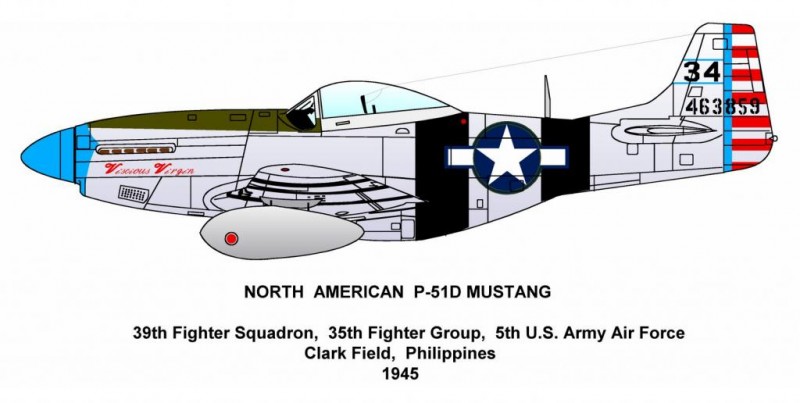
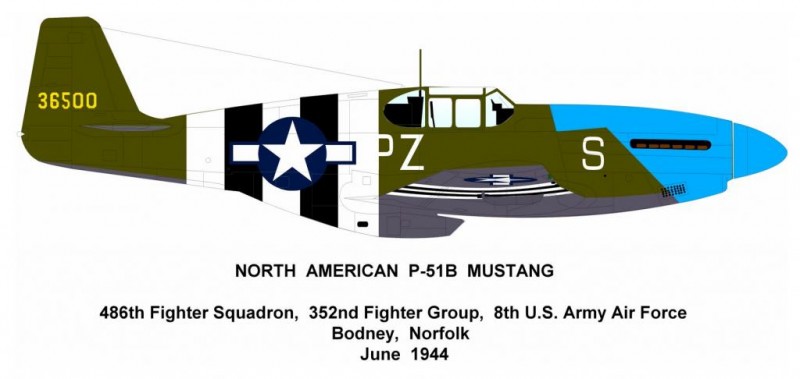
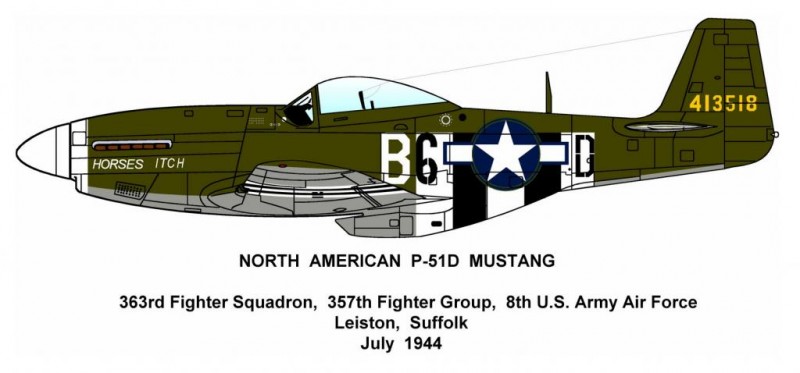
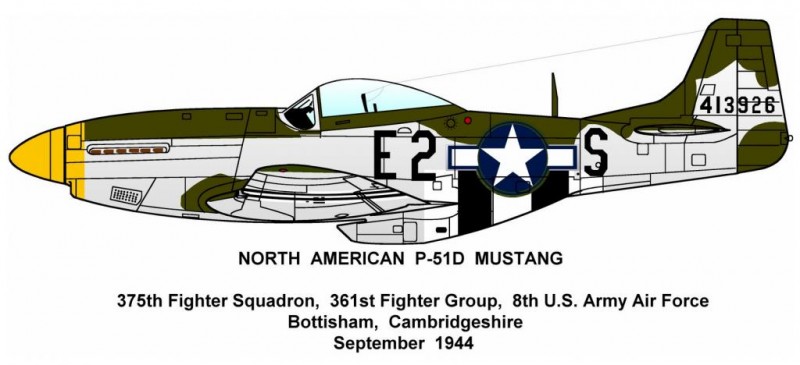
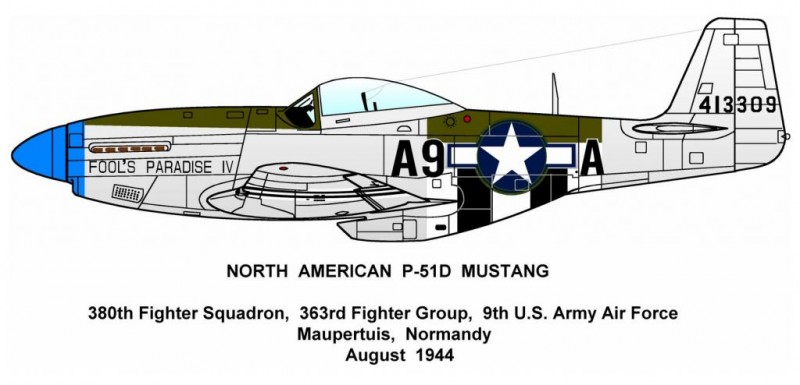
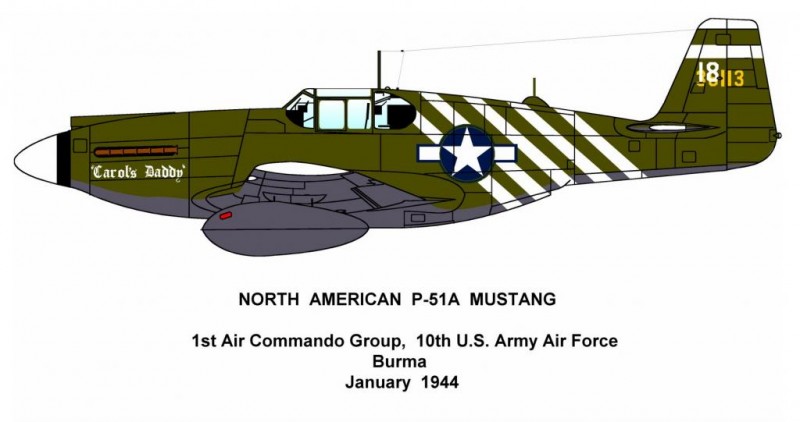
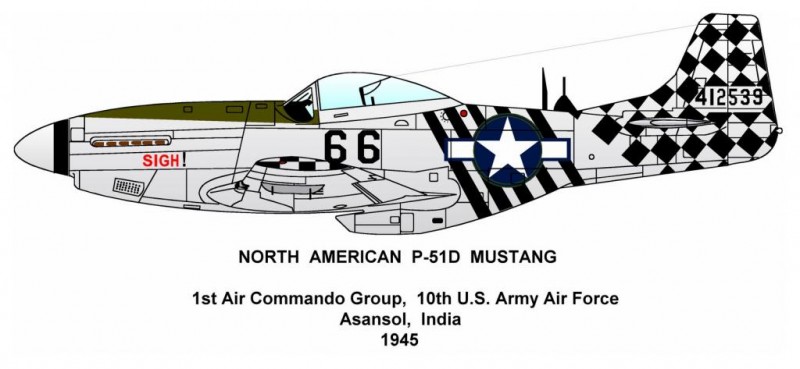
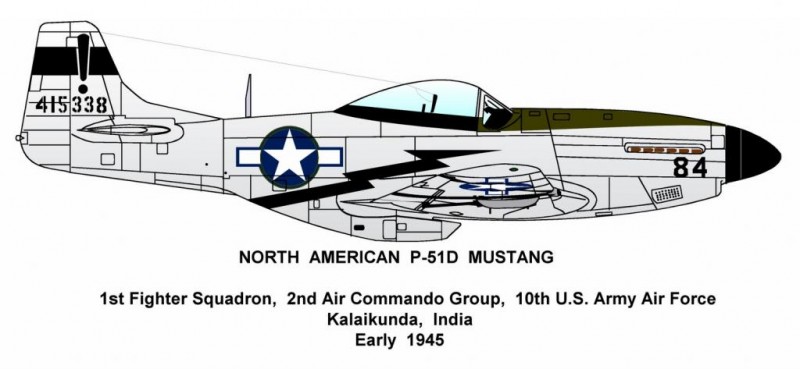
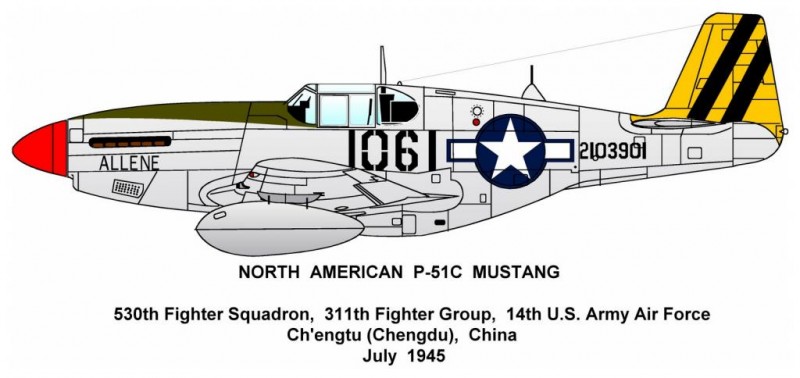
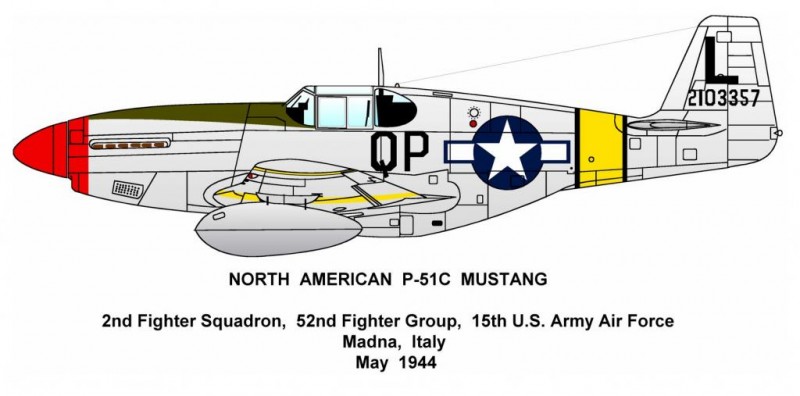
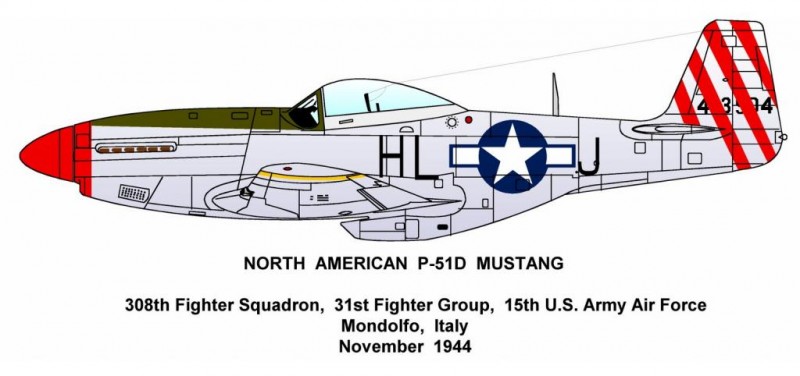
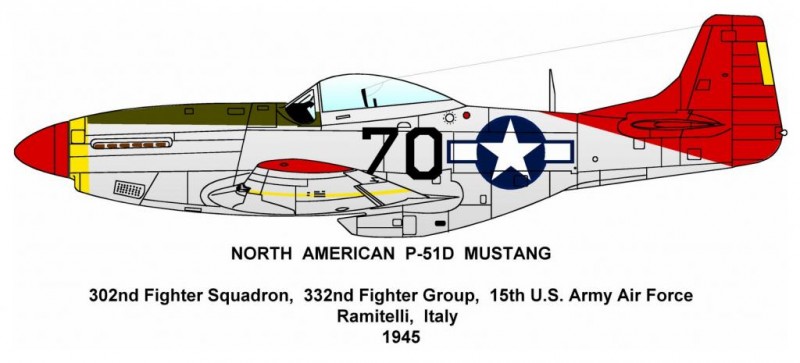
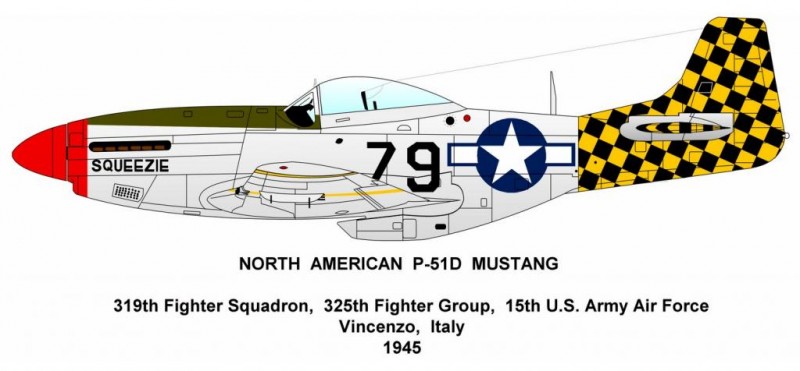
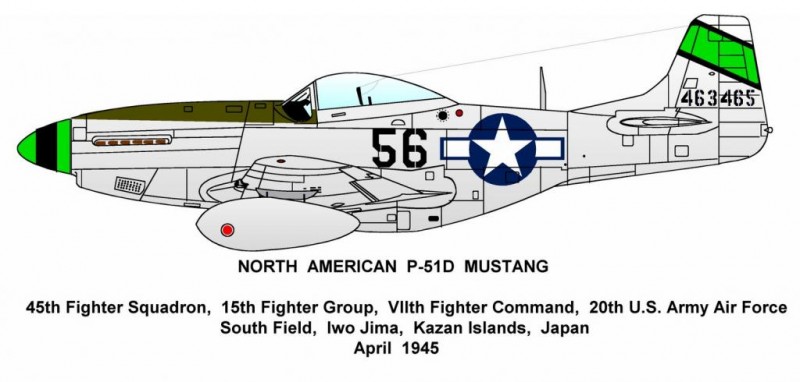
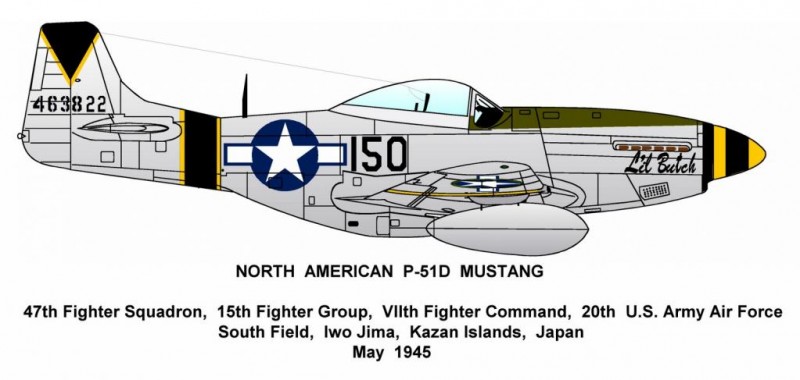
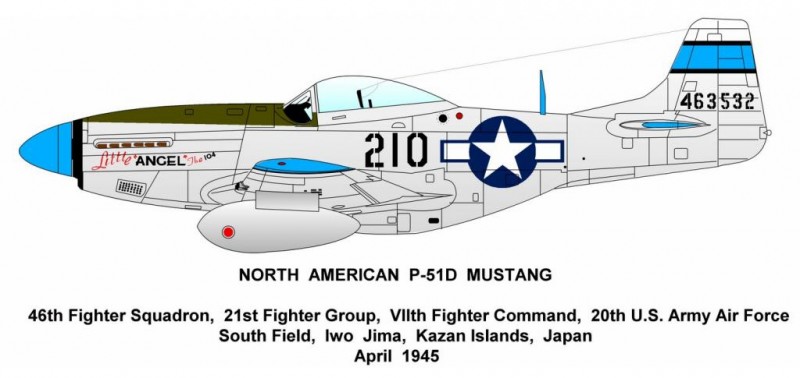
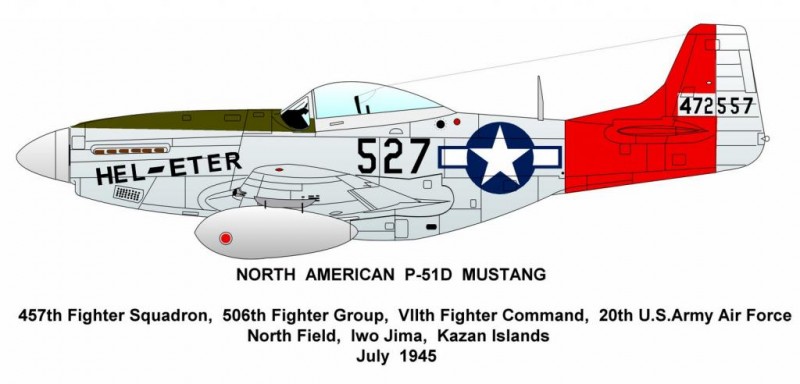
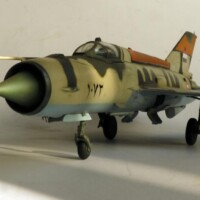
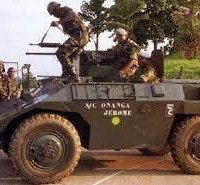
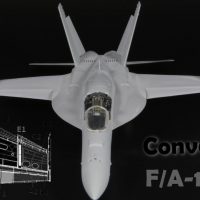
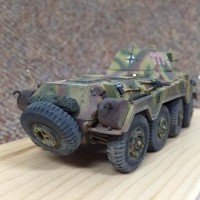
Beautiful, Martin.
Brilliant Martin - now where did i put that 1/32 Hasegawa P-51 I had...?
Martin I really appreciate you sharing these articles that are in your archives. I'm filing them for future reference.
Thanks. I'm a long-time fan of Rick Kent, his profiles and even more importantly his vast knowledge about the aircraft he depicted. I still remember the excitement of receiving every new piece from him.
Counting in the web years, these articles may be old, but I think they're well worth refreshing so that we can continue enjoying them for a few more years.
loved your article, I have a picture of a red nosed P-51D (Serial Number 44-72336) of the 361st Fighter Group. I researched it to a Capt. Donald J Pierce. 434th Fighter Squadron. P-51D 44-72336 L2-R “Setonia No. 3. I am confused to the different units associated through web searches. When Pierce flew it it had no red nose, in the picture it has a red nose but mentions no association to Pierce. Which one is correct?
appreciate any help
Ed
The only marking I can see from angle of the pic is that the wings have stripes, starting with white near fuselage, then black, white, black and then white towards tips of wings. the right wing has a typical black circle with white star, rear wing (I guess that's what its called) has one black stripe, I can see nothing else.
similar to this http://www.military-art.com/mall/images/nt1.jpg
What do the letters and numbers on the Mustangs fuseladge mean?
Where can I find the P51D from 1944 for the 479th fighter group, 436th fighter squadron?
Perfect! I needed some ideas and this helps!
Thanks!
Where can we find photos of P51s operating over Korea that were based in Japan during 1950 and early 1951?
Your site is superb.
Roger,
Glad you like the site, why not register and join our network - here, everyone's welcome to contribute.
As for the photos of japan-based P-51s I'm afraid that I don't have much to come with. Maybe except for my usual research tool: the Google Image search, which I was able to narrow down to this:
https://www.google.se/search?q=p-51%20japan%20korean%20war&tbm=isch&tbs=ic:gray&sourceid=chrome-psyapi2&espv=&biw=1680&bih=949&dpr=1&cad=cbv&sei=MmDrU43EK6XMyAOUi4CIAg#q=p-51%20korean%20war%20japan&tbm=isch&tbs=ic:gray&imgdii=_
i've read things suggesting that mustangs came with the wings painted silver. can you comment on the veracity of such claims?
For all I tknow, this was true. P-51Ds at least came with the wings puttied and painted silver to facilitate laminar flow over the wing.
Looking for color scheme for the 8TH, P51's A,B,C,D From the 355 FG, 357 FS. Letters 'OS', 1943 1944. Anyone have info.thanks
Dear Martin,
I have to tell you that you're incorrect on the markings of the 47th Fighter Squadron. I was in the 47th, and flew plane #172 "Clamwinkle McSlop" in 1945 on missions from Iwo Jima to Japan. The "V" in the tail was not black, but was a dark purple, with the outline in yellow. The bands around the wings and fuselage were also deep purple with yellow outlines. The anti-glare mat on the top of the engine cowling was flat black, not olive drab. I can also tell you that this was an ideal paint scheme, There were so many planes being replaced due to losses that sometimes they only had time to paint the star, and the "V" in the tail before being sent off.
Sincerely yours,
Donald L. Kiggins, Sr.
Hi I'd dearly love a colour scheme/markings for Cpt Thomas Mantell's P51 Mustang, which famously crashed after allegedly chasing a U.F.O. please if anyone can help? All the info I have is the ANG letters for Air National Guard, but thats it.